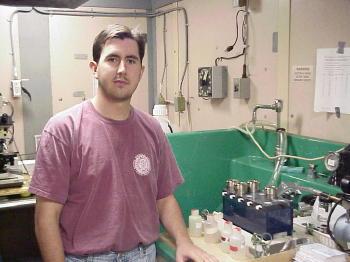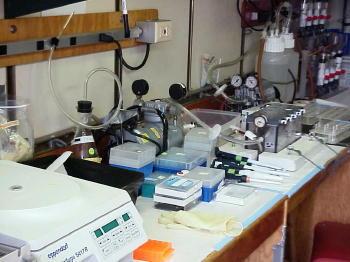
|
|
26 July, 2002
We are at BC 6. That means that this is our 6th
station in Barrow Canyon. Due to the depth of 2000
meters, the sloping canyon walls, and the loss of
several hours to helicopter operations, the station
has already taken nearly 35 hours. The multi-Haps
core is the next to the last sampling procedure and we
are in the process of sending the Haps core down one
more time. Iím working on my journal while we wait to
get back to the correct depth for a third try. We
need six of the eight cores we would usually get from
two trips to the bottom. However, the first try came
up with two empty core tubes, and the Haps never
tripped (released the coring buckets) on the second
trip. Itís important to get all the required
information at each station; thatís why weíre going to
try again. Hopefully by tomorrow Iíll have a series
of pictures of the Haps core process for you. It was
a good day for pictures as the sun came out for the
first time in several days. Despite the snow flurries
in the air, it felt positively balmy outside. Either
Iím getting used to the Arctic weather, or it is just
so beautiful that I donít notice the cold as much.
Today I spoke with Matt Cottrell and Rex Malstrom from
the University of Delaware. Matt is an associate
scientist in the College of Marine Studies, and he is
working with David Kirchman, also from the University
of Delaware. Whenever I am collecting water from the
CTD cast, I always see Matt there. He collects water
from five depths, three in the photic zone (remember
that photo means light) and two from below the photic
zone where light does not penetrate. He then splits
each sample into three sub samples which he will
incubate (put them into an environment where they can
grow) for one, two, or three days. Since he is
looking at the decrease in oxygen, he will incubate
his samples in the dark so no new oxygen will be
formed by any phytoplankton (plant like organisms that
produce oxygen through photosynthesis) in the sample.
The reason Matt is measuring the decrease in oxygen is
to get an idea of the bacterial population in the
depth of water from which he sampled. Bacteria are
truly everywhere in our environment, and the Arctic
Ocean is no exception. As a matter of fact, bacterial
consumption is responsible for about one-half of the
measured decrease in oxygen!
Rexís project is related to Mattís because Rex is
trying to find out the number of bacteria and how fast
they are growing. He also takes samples to be
analyzed later to identify what specific kinds of
bacteria he has in his samples. Bacteria are the most
abundant organisms in the ocean! Measure out one
milliliter of water (about 10 drops) and you would
find about a million bacteria! Bacteria help to turn
the carbon in organic (living) matter back to carbon
dioxide (CO2) by breathing in oxygen and breathing out
the CO2 as they break down their food. About 50% of
the carbon that is ďfixedĒ by phytoplankton (they take
the CO2, an inorganic molecule, and turn it into a
form of carbon that organisms can use) goes into the
microbial loop (micro = tiny, bio = life) this way.
The bacteria turn dissolved organic matter back into
CO2 or into more bacteria. By measuring the number of
bacteria present, Rex hopes to tell how much CO2 the
bacteria produce. Rex filters his water sample
through an extremely fine filter to remove the
bacteria. He then treats the bacteria so they glow in
the dark and he can count them under a microscope.
Because very little is known about the kinds of
bacteria that live in the Arctic Ocean, Rex is also
collecting samples to take back for identification.
Lastly, Rex is trying to determine how quickly the
bacteria are growing by measuring protein synthesis
(building) and DNA synthesis and calculating to get a
growth rate. (My students should understand why this
would be a good measure to determine growth.)
Although it took many hours to complete this station,
everyone was able to get the samples they needed. At
3000 meters, our next station will be the deepest one
yet. It will be another very long station. Think of
people like Matt who has samples that must be
incubated for one, two or three days before he can
analyze them. He is very grateful that we have a bit
of extra time over the next day or two. Even with the
extra time, he wonít get completely caught up, but he
will be closer.

Rex Malstrom is trying to find out the number of bacteria and how fast they are growing. This will give him an idea of how much carbon dioxide the bacteria produce.

Matt Cottrell collects water samples, incubates them for 1,2,or 3 days in the dark, and analyzes each one for the decrease in oxygen. From this, he gets an idea of the size of the bacteria population in the water.

Rex Malstrom does some of his work in the chem van on the bow. This is a separate area where radioisotopes are analyzed.
Contact the TEA in the field at
.
If you cannot connect through your browser, copy the
TEA's e-mail address in the "To:" line of
your favorite e-mail package.
|
